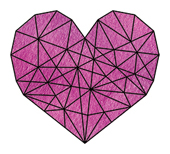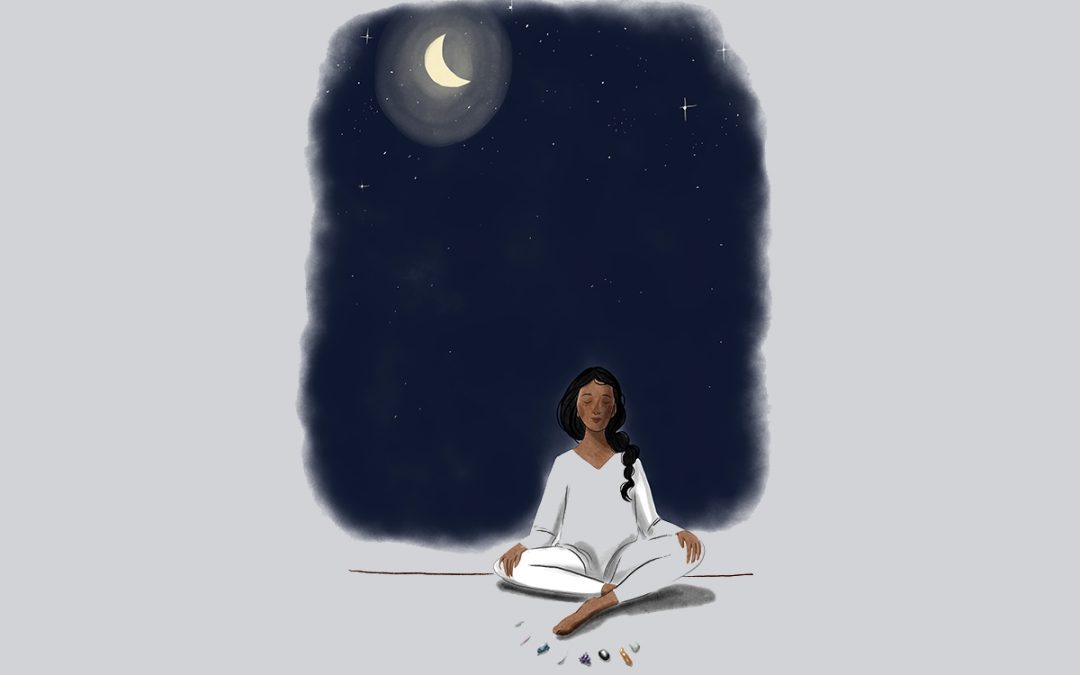There’s a hush, a stillness that falls in the deep midwinter. It’s the time of year when many creatures hibernate, hiding themselves away to slumber through the lean times. So don’t beat yourself up if you’re not feeling the urge to be wildly sociable; if the idea of New Year parties makes you wince. This is a time to hunker down, to snuggle up by the fire and keep warm, to sleep longer, to dream.
Let’s embrace the pause of winter. I like to think of winter as the season of the soul, a chance to attend to our innermost needs and yearnings, an opportunity to go deep, without the distractions of the busier seasons. It’s a good time to unwind and reassess the directions to be taken in the forthcoming new year.
In my new book, Ancient Wisdom for Modern Living (Sterling Ethos), I share a whole host of tips and techniques for seasonal living. Let’s look at some practices that are perfect for deep winter and the start of the new decade.
Winter – the season of deep yin
In the Chinese system, winter is the season of deep yin energy. It’s linked to the element of water, full of hidden potential. Water rules the lymphatic system, our hormones, the bladder and kidneys. It also rules our ears and hearing, our teeth, our sexual organs and our bones, especially the skull and spine. It’s a curious list.
We’ll be concentrating on the two major winter organs, the bladder and the kidneys. The bladder is thought to be the seat of the emotions in the body and bladder meridian imbalances can show up as being fearful, resistant to change – you might be pessimistic and easily triggered.
Meanwhile our kidneys store the energy of the life force itself, they relate to our entire life cycle. Willpower is a trait associated with the kidneys and, if you feel as if yours is perilously close to nil, you might well have a water imbalance.
The kidney meridian is also associated with bone marrow, the growth of new blood cells and nourishment. Weak kidneys can lead to immune deficiencies. As winter is the time of chills and flu, it’s even more important to focus on the bladder and kidney meridians at this time of year. Above all, keep those warm and cosy (a hot water bottle swathed in a cosy wrapper does the job nicely).
In Chinese medicine the brain and spinal cord are also forms of marrow, so an inability to think clearly and poor memory are signs of deficiency kidney energy. The kidneys are the centre of courage so imbalances also manifest as fear, nervousness and even paranoia (as with bladder imbalance). Our emotional ability to deal with stress falters. Using our will power and following our own direction can be powerful processes here.
The winter diet
Our winter diet is predominantly warm and nourishing. I hate the way that New Year now seems to be synonymous with dieting these days. Please don’t do it. You’re working against your body and against nature. Yes, you might lose weight but at the cost of leaving your body open to colds in the short term, and deeper imbalances long-term. Wait until spring.
Take your cue from nature – if you eat seasonally and locally, you won’t go far wrong. Root vegetables really come into their own at this time of year – let them form the basis of rib-sticking soups and stews. If you’re a meat-eater, follow the ancient tradition of using just a little meat to add flavour to a hearty stew.
Get your greens. Again, there are plenty of seasonal options – cabbage, cauliflower, leeks, broccoli and Brussels sprouts are all in season- and pack a great nutritional punch. Bulk up everything with onion and garlic, the great purifiers and strengtheners.
Wholegrains and pulses add a further solidity to your food – experiment with the full array of ancient grains and legumes.
Ancient physicians say that the tastes to look out for in winter are those which soothe vata – predominantly sweet, sour and salty. Just don’t let that become an excuse for overdosing on chocolates and chips!
Golden milk
I’ve been using turmeric in my cooking for aeons but it wasn’t until I visited Rajasthan that I discovered Golden milk, a comforting mix of plant-based milk, turmeric and other healthy powerhouses. You can buy ready-mixes but it’s nicer to make your own from scratch – and, truly, it’s easy.
Place two cups (500ml) of your chosen milk into a small saucepan. Add two teaspoons of turmeric (either ground or freshly grated) along with a good pinch of ground black pepper and a dessertspoon of coconut oil. You can also add a little ground ginger and cinnamon if you like, and sweeten with maple syrup, honey, coconut sugar or a drop or two of stevia.
Heat gently, whisking frequently, until steam comes off and it’s nice and hot, but the mixture is not boiling. Now take off the heat and adjust for sweetness and spice. Pour into your favourite mug and sip thoughtfully (preferably while watching a fire or gazing out the window).
Sacred cacao
Once you’ve tasted true hot cacao you will never want to settle for plain old hot chocolate again. Raw cacao powder is complex. Apparently it contains more than 250 different chemical compounds; it has four times the antioxidant power of 70 percent dark chocolate and 20 times that of blueberries. It’s rich in iron, potassium, zinc, calcium, thiamine, riboflavin and magnesium. Plus, of course, it tastes gorgeous and feels like a hug in a cup.
Simply place a cup (250ml) of your favourite plant-based milk in a saucepan. I veer between coconut and almond for this one – and sometimes use half and half. Add two teaspoons of raw cacao (you’ll need the powder, not the nibs, in order for it to blend nicely). Pop in a teaspoon of almond or cashew butter (it makes it super-unctuous). Add your choice of natural sweetener. Some souls like to add spices – cinnamon works well. Experiment – make it your own.
Heat gently, as for Golden Milk – so watch it doesn’t boil. Equally, it will need to be hot enough for the nut butter to melt. Decant, sip and dream.
Thymus tapping
The thymus is a small gland in the centre of the sternum (breast bone). It is a major part of our lymph system and deserves attention. Plus the practice is deeply soothing.
- Stand in Mountain pose (Tadasana) with your feet nice and square under your hips and your shoulders relaxed. Now tap your thymus.
- With your fingertips tap firmly all across the centre of the sternum and widen out across the ribcage to include the top part of the kidney meridian, until you can feel a pleasant stimulation and the area is energised.
- Now rub your hands together to create more warmth and place them on the kidneys themselves (the soft area of your back between the lower ribs and the top of the hips). Give yourself a gentle rub, calming, self-soothing and warming.
- Spend some minutes practicing Ocean Breath – a soft throaty pranayama that’s Ujjayi Breath’s little cousin. Imagine that you are trying to fog up a mirror in front of you, blowing on it with an open mouth. Now breathe that way but with your mouth closed. The throat constricts ever so gently, like a soft snore or like the sound of the sea, each breath a wave rolling to shore. It’s a soft slow breath, long and relaxed, always through the nose.This pranayama practice builds heat in the body and focuses the mind. It can be both soothing and empowering as you enter into your own inner ocean.
Laughter yoga
Laughter Yoga is perfect for this time of year as it directly affects our emotional body which is governed by the kidney and bladder meridians. If your bladder meridian is very unbalanced you may resist this vehemently. It will seem silly and ridiculous. Great! It’s a sign you really need it. Here’s the thing – the body doesn’t know the difference between pretend laughter and genuine laughter. The embodiment of joy that this practice creates has many documented benefits (improved immune and lymphatic function, plus re-oxygenation of the blood and cells of the body, all relevant to our kidney and bladder qi).
- Give yourself a big shake, just like a dog coming out of water.
- Raise your hands towards the ceiling on a big belly inhale and then exhale with a big HHHAAA, longer than the inhale. Repeat a couple of times.
- Next, instead of your HHHAAA sound, laugh on the exhale. Let it all go. HO HO HO. HA HA HA. Just laugh. It may feel really ludicrous in which case just laugh at the sheer insanity of it. Persevere, fake it, just do it. Keep going until you are genuinely laughing – it happens – and then laugh into your very bones. Close your eyes and feel your skeleton.
- Laugh and let go of anything that you don’t need any more.
- When you are finished just stand quietly, hands over kidneys, smiling into your body and all its wonderful processes.
Bathing
Nothing beats a hot bath in winter. The ancient Egyptians, Babylonians, Greeks and Romans all extolled the virtues of a long soak – and therapeutic bathing is still revered in many cultures (from Russia’s ‘banya’ to Japan’s ‘furo’ and ‘sento’, not forgetting the wonders of the Arabic hammam).
Modern research is now proving what the ancients knew all along. A good bath can help banish stress, soothe insomnia and relieve aches and pains. It can improve cardiovascular health and it can even help reduce blood sugar levels in diabetics –the heat dilates blood vessels, improving blood flow and helping the body make better use of insulin. The tub has even been shown to ease loneliness – the warm water acts as a watery alternative to a good hug.
For stress-reduction: Soaking in warm water daily has been shown to be better at easing anxiety and stress than a prescription drug. The key here is to avoid a very hot bath – aim for warm or neutral (body temperature) for the best stress-reduction. Essential oils can boost the stress-reducing effect – the most effective include lavender, rose, geranium and bergamot.
For insomnia: Having a warm bath just before bedtime temporarily raises your body temperature and then, as you get out the bath, it lowers, telling the body to produce melatonin, which induces sleep. The warm water also soothes muscle tension. Use either a long hot bath or a shorter, 15-minute neutral (body temperature) bath. Essential oils can increase the soporific effects, having a marked effect on sleep and its quality. Lavender, sweet basil and jasmine score high in the tranquillity stakes. Research has found that jasmine essential oil has a direct effect on a brain chemical called GABA, helping to soothe anxiety and encourage good sleep.
For aches and pains: Whether you ache from a tough workout or from joint problems, a deep hot bath can be helpful. If you can face it, alternating hot and cold baths (or showers) can make a difference. However, for now, keep to warm – experiment with the level of heat, so you don’t cause yourself more pain. Epsom salts (made from the mineral magnesium sulphate) help to sedate the nervous system and relax muscles.
Caution: Do not use heat on a fresh injury as it can increase blood flow and inflammation and cause tissue swelling.
For emotional healing: It’s not just physical; a warm bath has a proven effect on improving mood and emotional wellbeing. The water really does comfort and soothe – who knows, maybe it takes us back to the womb? Make your bath-time a regular soothing night-time ritual, using candles and warm towels alongside bath unguents (over time your mind will come to recognise bath-time as a prompt to relax and feel good).
Note: When it comes to bath potions and unguents, keep it natural. It usually takes chemicals to get baths foaming and frothing and, truly, you don’t want to absorb nasties through your skin.
Dreamworking
Most ancient cultures took dreams very seriously. Dreams can be a passport to a renewed sense of creativity, a fresh way of working out tricky problems and relationships, a means of realizing your deepest desires and coming to terms with your deepest fears. They can even alert you to health issues.
Some psychotherapists (particularly those working in the Jungian tradition) say that a dream is our unconscious talking directly to us – it’s a direct route to the psyche. Interestingly, it is not only emotional or mental relief that can come from working with dreams. Often quite physical symptoms can vanish. This can be powerful and sometimes painful work and you might feel more comfortable working with a trained therapist if difficult emotions or memories start to emerge.
If you never remember dreams, try setting a (gentle) alarm to wake you around 90 minutes after you usually fall asleep. Most dreams happen in REM sleep towards the end of each of our 90 minute sleep cycles.
Working with dreams
Often, simply writing down your dream can bring insights. However these techniques can help you work further with you dreams.
- If a particularly strong or puzzling character appears in a dream try this technique. Place two cushions facing each other. Sit down on one and imagine your dream character on the other. Tell the character how you felt and ask it a question. Maybe you were frightened by it, or puzzled by its words or actions. Then switch places and imagine you are the dream character – answer the questions. You may be surprised at what comes up.
- Draw or paint a powerful dream. It doesn’t need to be ‘good art’ in any way. You can either paint a scene from your dream or simply use colour and shape to express the mood of the dream. What do you notice when you see it expressed on paper? Try turning the picture on its head or side – sometimes other things will pop into your head.
- ‘Dream the dream on’. Breathe deeply to relax yourself. Now take yourself back into the dream. Let your imagination run free to imagine what might happen next.
Wishing you a happy, healthy, soulful new year!
Excerpted from Ancient Wisdom for Modern Living – From Ayurveda to Zen, Seasonal Wisdom for Clarity and Balance by Jane Alexander (Sterling Ethos).
 |

Jane Alexander is an acknowledged authority on spirituality and wellbeing, having studied natural therapies and ancient wisdom for 40 years. She is author of over 20 books, including the bestselling Spirit of the Home, The Smudging and Blessings Book, and The Energy Secret. Her latest book is Ancient Wisdom for Modern Living (Sterling Ethos).




